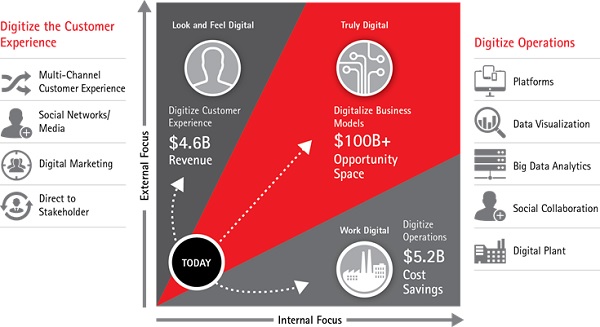Capturing a $100 billion digital opportunity

There is big money at stake as a result of the digital revolution in healthcare, with digital disruption having the potential to unlock billions of commercial value in the US over a five-year period through new business models, suggests Kenneth Munie.
Life sciences leaders should not get trapped in the 'get digital quick' way of thinking that making individual customer experiences and operations digital will automatically transform them into a fully-functioning digital business.
Making individual processes digital, such as issuing tablets to sales reps, can certainly increase efficiency, but it does not change a company's business model or growth potential.
"What are needed are true game-changing approaches to doing business that will produce new bottom-line value in operations"
While it is critical to start the process of comprehensive digital adoption sooner rather than later and the bite-size approach may feel more comfortable, small silo adoptions are only able to grow a small portion of digital's full value. What are needed are true game-changing approaches to doing business that will produce new bottom-line value in operations.
Some companies are already diving in to shift value in life sciences or across industries. For example, smartphone apps and wearables are delaying or preventing the need for medication. Some can also function as medical devices for diagnostic, monitoring and supporting treatment solutions.
Unlocking commercial value
Digital disruption could unlock more than $100 billion of commercial value in the US over a five-year period. However, will traditional players in life sciences capture the lion's share of the money and market, or will companies from other segments of the healthcare industry, or from consumer products, high tech, or communications move in?

Figure 1: Sources of Commercial Digital Value in Healthcare for Life Sciences
The digital opportunity is hard to digest due to its diverse landscape. Figure 1 can help to simplify it.
In the US branded pharmaceutical market, customer experience could drive $4.6 billion in incremental revenue and digitising commercial operations could yield $5.2 billion in cost efficiencies industry-wide over five years. These opportunities are real and have benefits beyond the numbers, including speed and simplification. However, improvements to discrete business processes represent only a relatively small portion of digital's potential full value in the US healthcare market.
The estimates reported here for the impact of digital services on diabetes are based on the 2014 US Centers for Disease Control diabetes prevalence figures on the number of diabetics and the cost for treating diabetes in the US. For each disruption, the impact was calculated based on the change to the number of patients, visits, or expenses as described in each section. The treatment of type 2 diabetes alone has the potential to shift more than $100 billion in value from traditional to emerging business models over a five-year period.
Digital disruptions create entirely new ways of interacting across multiple dimensions – both internally and externally. Two broad categories of disruptions that will impact life sciences include:
1. A shift in value within or across industries. Digital disruption has removed traditional manual middlemen in an industry's distribution chain, such as book stores, and has added new digital middlemen, such as virtual stores for digital music and mobile apps.
• Patients and providers are using digital technology to shift value, sharing medical resources and costs. Novel communities are forming in which patients or providers share medications and supplies at lower cost than charged by traditional pharmacies and equipment suppliers. One digital start-up has developed cloud-based software that helps hospitals share their medical equipment, giving each one access to significantly more equipment than it individually stocks.
• Innovative companies are offering consumers monetary rewards for participating in healthy activities. For example, Redbrick Health has a programme that provides consumers – most often employees of participating companies – with the opportunity to log their activities in exchange for points that can be applied to purchases. Another example is Nike's wearable fitness device FuelBand. Recently, Nike piloted a programme in New York City that allowed consumers to record their fitness activities on FuelBand for points which could be used as currency to purchase items like socks, shirts and hats from a vending machine designed exclusively for that purpose.
2. A change in the nature of control points. The critical control points for influencing decisions or actions in healthcare have also changed. Physical presence, scale and scope have become less important as digital technology has brought new alternatives, including customer data, subscriptions and personal, smart devices.
• Digital technology is re-setting the standard for treatment. It can now support algorithms and remote monitoring, replacing individual decisions by health care providers. This frees physicians' time and can improve clinical decisions. An example is WellDoc's BlueStar platform. Recently approved by the US Food and Drug Administration, the platform is the first mobile prescription therapy for type 2 diabetes. It provides real-time motivational, behavioural and educational coaching to help patients self-manage their diabetes treatment plan and is reimbursable by insurers.
• Patients are also leveraging digital technology to change the nature of control points through creating new streamlining intermediaries. The ability to offer access to services in real-time and from any location is one of the major benefits of digital technology. For example, Walgreens is piloting a service that gives patients in California and Michigan 24/7 access to physicians through its mobile app. For conditions that don't require a physical examination, such as pink eye or bronchitis, physicians can offer a diagnosis and treatment and write prescriptions. Doctor on Demand is another mobile app that offers appointments with state-licensed doctors over video for just $40. The doctors can also prescribe medications and send them to the patient's local pharmacy.
Five actions to capture value
To help capture value and grow market share:
• Assess the opportunities and risks pertaining to digital substitutes for therapies, such as smartphone apps. Consider how to enter the digital substitutes market, and defend against new entrants by increasing the value of therapy provided through traditional patient services.
• Conduct a robust and ongoing patient value analysis based on real-world examples. Use predictive intelligence and analytics to identify sub-populations who would gain the most benefit from therapies and services in therapeutic areas where digital resources provide a standard for treatment decisions.
• Redefine the sales role as the 'rep of the future' to effectively convey the value of therapies. Reps will need to reach out to healthcare providers who interact with patients online or through call centres. Life sciences companies will need new strategies for creating content.
• Build capabilities to facilitate and engage with customer communities to capitalise on opportunities in the sharing economy. For example, one pharma company uses social networking and crowdfunding to create a virtual support system for patients seeking to live healthier lives. Further, companies must defend their market position against the sharing economy by identifying ways to strengthen their personalised patient services.
• Develop a digital ecosystem that will offer monetary rewards for health-conscious behaviour. Life sciences companies can build capabilities and partnerships with retail or technology companies, for instance, to enable better adherence and compliance through direct, relevant incentives for patients.
Traditional life sciences companies must decide whether they will lead the charge by becoming a digital transformer, or just be a follower. Companies that intend on becoming transformers must take a fresh look at their capabilities and business models in order to determine how they can digitally unlock significant value for their business and patients. Life sciences companies will need courage, inspiration, effort and be willing to take risks in order to lead the pack of digital followers into the future investments of the industry.
About the author:
Kenneth Munie is managing director at Accenture Life Sciences.
Read more from Accenture:
Unite pharma's marketing and information capabilities for greater success











